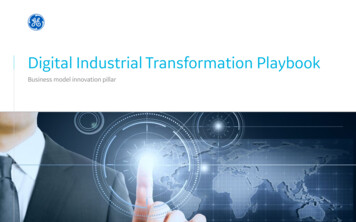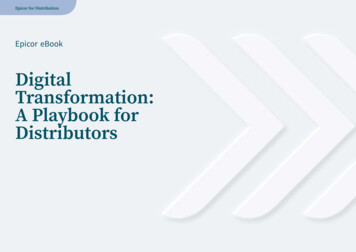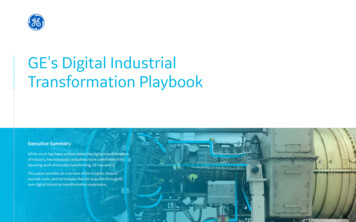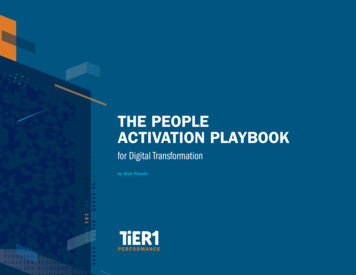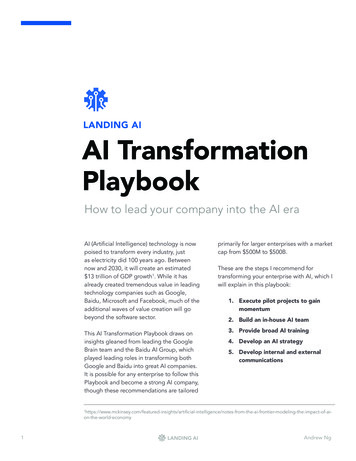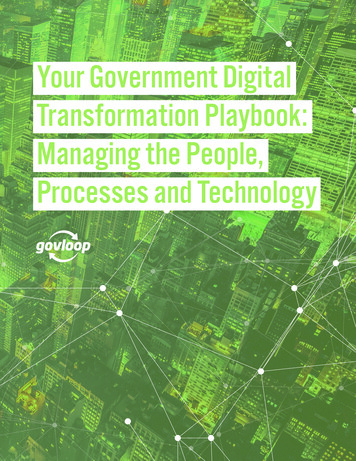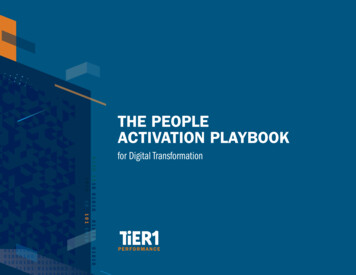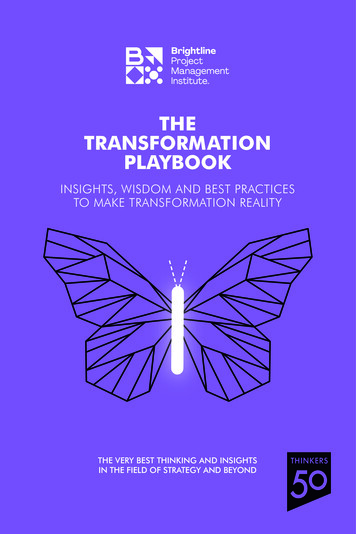
Transcription
THETRANSFORMATIONPLAYBOOKINSIGHTS, WISDOM AND BEST PRACTICESTO MAKE TRANSFORMATION REALITYTHE VERY BEST THINKING AND INSIGHTSIN THE FIELD OF STRATEGY AND BEYOND
ABOUTTHINKERS50ABOUTBRIGHTLINE INITIATIVEThinkers50 (thinkers50.com) identifies, ranksand shares the greatest management ideasof our times. Its definitive global rankingof management thinkers is published everytwo years.Brightline is a Project Management Institute(PMI) initiative together with leading globalorganizations dedicated to helping executivesbridge the expensive and unproductive gapbetween strategy design and delivery.Since its launch in 2001, the ranking hasbeen topped by Peter Drucker, MichaelPorter, CK Prahalad, Clayton Christensenand Roger Martin. The Thinkers50Distinguished Achievement Awards havebeen described by the Financial Timesas ‘the Oscars of management thinking’.It delivers insights and solutions that empowerleaders to successfully transform theirorganization’s vision into reality throughstrategic initiative management.Thinkers50 has ten established criteria by whichthinkers are evaluated – relevance; rigour;reach; resilience; influence; media coverage;presence; affiliations; communications skills;and tools and techniques.Thinkers50 champions the latest managementideas worldwide. Thinkers50 Europe is apartnership between Thinkers50 and theCity of Odense, Denmark. It hosts the annualThinkers50 European Business Forum.Thinkers50 China is based in Qingdaoand is a partnership with the Haier Group.It is home to the Thinkers50 Hall of Fame.Learn more at www.brightline.org.Brightline CoalitionProject Management Institute – BostonConsulting Group – Agile Alliance –Bristol-Myers Squibb – Saudi TelecomCompany – Lee Hecht Harrison – NetEaseAcademic and Research CollaborationTechnical University of Denmark – MITConsortium for Engineering ProgramExcellence – Duke CE – Insper – IESE –University of Tokyo Global Teamwork Lab –Blockchain Research Institute
THE TRANSFORMATION PLAYBOOKInsights, wisdom, and best practices to make transformation s50 LimitedThe Studio, Highfield Lane, Wargrave RG10 8PZUnited KingdomFirst published in Great Britain 2019Copyright NoticeThe Transformation Playbook is copyrighted material of and ownedby the Project Management Institute, Inc. (PMI). Copyright 2019.Trademark Notice“PMI”, the PMI logo, and “Brightline,” are marks or registered marks of theProject Management Institute, Inc. in the United States and other nations. All othermarks that appear in this publication are the property of their respective owners.Design by www.jebensdesign.co.ukAll rights reserved. No part of this publication may be reproduced, stored ina retrieval system, or transmitted in any form or by any means, electronic,mechanical, photocopying, recording or otherwise without the prior writtenpermission of the Publishers. This book may not be lent, resold, hired out orotherwise disposed of by way of trade in any form of binding or cover otherthan that in which it is published, without the prior consent of the publishers.ISBN:PDF Edition 9781999315733ePub Edition 9781999315740Kindle Edition 9781999315757Print Edition 9781999315726BRIGHTLINE INITIATIVE / THINKERS50 / THE TRANSFORMATION PLAYBOOK1
‘If you want truly tounderstand something,try to change it.’KURT LEWIN2
THE TRANSFORMATION do Viana VargasForewordSunil PrasharaThe human side of digital transformationBehnam Tabrizi, Ed Lam, Kirk Girard & Vernon IrvinThe fundamental problem with transformationimplementationRoger L. MartinA purpose-driven transformationMurat BicakThe digital transformer’s dilemma: how to sustain successin the core while building a new digital businessKarolin Frankenberger, Hannah Mayer, Andreas Reiter & MarkusSchmidtThe new era of change managementReinhard Messenboeck, Grant McCabe, Perry Keenan, JeanneKwong Bickford & Michelle Stohlmeyer RussellPreemptive transformation: fix it before it breaksMartin Reeves, Lars Faeste, Fabien Hassan, Harshal Parikh & KevinWhitakerSchein on changeGeorgina PetersUsing crisis as a catalyst for transformationEdivandro Carlos Conforto, Ricardo Viana Vargas & Tahirou AssaneOumarouFour transformation traps and how to avoid themClaudio Garcia, Kaihan Krippendorff, Zachary Ness, et alTransformation in the 21st Century: how not to implementchange initiativesAlexandra Levit3
72788391991071171251291351411491551641691751804A roadmap for creating digitally-enabled organizationsFabrizio SalvadorFear: The big inhibitor of innovation and transformationEdward D. Hess & Donna MurdochTo out-transform your competition, activate internalentrepreneursKaihan KrippendorffAn unlikely case of successful digital transformationThales Teixeira, Leandro Guissoni & Frederico TrajanoKotter on changeDes DearloveFrom transformation insanity to enterprise instancy:catalyzing an adaptive leadership systemTony O’DriscollThe role and functions for transformationDavid Kallás, Carlos Afonso Caldeira & Fabiana Cherubim BortoletoTransforming culturePeter BregmanThe I.AM frameworkDeborah RowlandThe A to Z of transformationAndy VeseyThe discipline of changeSusie Kennedy & Andrew BrayThe human side of transformationTendayi VikiKanter on changeStuart CrainerOpening up to transformChristian StadlerThe transformation: how Michelin redefined the twentyfirst century industrial corporationIsaac GetzSensemaking and interpretation in transformationAlf RehnResilient transformationsVerena Stingl, Morten Wied & Josef Oehmen
THE TRANSFORMATION PLAYBOOK / CONTENTS186193198204209215Digital transformation: make people first!Paul DinsmoreDigital execution: what it takes to succeedRobin SpeculandAre you ready?Rita TrehanCan caterpillars fly?Sharon Olivier & Frederick HolscherMaking sense of the transforming power of AIMark Esposito & Terence TseWhat can the survivors teach us?Tiffani BovaBRIGHTLINE INITIATIVE / THINKERS50 / THE TRANSFORMATION PLAYBOOK5
THE TRANSFORMATION PLAYBOOKPrefaceThe Transformation Playbook is the third in a series of books the BrightlineInitiative has produced in partnership with Thinkers50. As with the first twobooks – Strategy@Work and The CSO Playbook – we have gathered togetherinsights from an array of practitioners and thinkers. They are a truly global andinspirational mix.The aim of The Transformation Playbook is to ignite debate and thinking.Gone are the days (if they ever truly existed) when there was one single bestanswer to a business challenge. Now, there are a profusion of differentapproaches, tools and techniques. Ideas abound. And, reassuringly, so too doesinspirational practice. Among the great transformation journeys recounted in thebook are those of Michelin, Li & Fung, CenturyLink and the Department ofPlanning and Development in California’s Santa Clara County.The linking theme to these stories and the ideas that fill the following pagesis simple: people.Our work at the Brightline Initiative has looked at strategy execution and thebarriers that frequently prevent great strategies becoming brilliant reality. Thebiggest barriers are human. The human side of transformation is a recurringtheme throughout The Transformation Playbook. One way or another, thepurpose of transformation must be to enhance people’s lives. To make thisreality demands that people are galvanized into dynamic action. Transformationis not a neat theory, but a human imperative in our fast-changing times.Transformation has never been more important and the human side oftransformation is now, at long last, being fully appreciated.We hope that The Transformation Playbook will challenge your own ideasabout what it takes to transform organizations. And, we also hope that it providesuseful and practical suggestions as to what to do when you start on your owntransformation journey.Start now!Ricardo Viana VargasExecutive Director, The Brightline Initiative6
‘We cannot become whatwe need to be byremaining what we are.’MAX DE PREEBRIGHTLINE INITIATIVE / THINKERS50 / THE TRANSFORMATION PLAYBOOK7
SUNIL PRASHARAForewordIn today’s digital economy, the greatest rewards flow to those with the greatestcapacity for change.Organizations around the world are grappling with unprecedented upheaval,driven by profound and fast-moving shifts in disruptive technology, demographics,and customer expectations.Empowered like never before with data-rich information at their fingertips,customers demand the highest quality services and products or they will quicklyturn elsewhere, compelling every executive and leader to stretch their thinking indeveloping new solutions. Innovation and technological advancements aremoving so quickly today that you may develop a new, differentiated way ofdelivering value, only for a competitor to come up with something as good (orbetter) within only a few weeks or months!The only way to maintain pace in this environment is to embrace a culture ofalmost continuous change, in which transformation is seen not as a singularevent, but as an ongoing journey.Every executive today will attest to the importance of cultivating effectivetransformation; many struggle to actually implement it. The Project ManagementInstitute and Forbes Insights conducted research in 2018, which found thatnearly 80 percent of organizations had undergone a significant transformationeffort over the past year that leveraged some type of disruptive technology.However, only about 25 percent of those initiatives have yielded tangible benefitsrealized against their original goals.Clearly, many executives are struggling when it comes to navigating thecomplex journey of change given the complexity and fast-moving nature oftoday’s technological landscape. So, what can be done to drive more successfultransformation?That’s what this book is all about. Inside you will find insights from experts,distinguished thought leaders, and change makers from a wide variety ofindustries around the globe.You’ll gain insights on how organizations can more effectively capture thevalue of emerging technologies, from 5G to blockchain and artificial intelligence.8
SUNIL PRASHARA / FOREWORDYou will take away a greater understanding of how to effectively harness thetalents of your entire team throughout every single stage of a transformation;even in the age of technology, change still succeeds or fails because of people.In my experience, leading large-scale change efforts throughout my career, fulltransparency is critical in carrying out effective transformation. I have learnedfirst-hand the power of having people involved in the change journey from thevery beginning through to the very end, and that requires communicating a clearvision of where you are heading together.A common theme that runs through virtually every successful transformationis the importance of projects and leveraging proven project managementpractices to deliver value. Yet in the traditional workplace that many of us havegrown accustomed to, work is largely organized around jobs defined by bulletedlists of static responsibilities. But the world is simply moving too fast to operateunder this paradigm; rather than carrying out the same work each day, manyprofessionals are increasingly called upon to tackle new challenges and embracenew approaches on a continual basis. We are far more likely to see a future inwhich more workplaces are organized around portfolios of projects, raisingdemand for talent who offer effective project skills and devote themselves tocontinually growing their abilities for the digital era.Read on to learn more about some of the incredible projects driving changeat leading organizations – and what you can do to strengthen your next largescale transformation effort.Sunil PrasharaPresident & CEO of the Project Management InstituteBRIGHTLINE INITIATIVE / THINKERS50 / THE TRANSFORMATION PLAYBOOK9
BEHNAM TABRIZI, ED LAM, KIRK GIRARD & VERNON IRVINThe human side of digitaltransformationDigital transformation (DT) – the application of digital capabilities toorganizations – promises to enhance efficiency, increase customersatisfaction, and uncover opportunities for growth. From big data, AI, blockchaintechnology, to the Cloud, many hail DT as the panacea to all organizationalproblems. Yet, 70 percent of all DT initiatives do not reach their goals. Of the 1.3 trillion that was spent on DT in 2018, 900 billion potentially went towaste. So, why do some DT efforts succeed and others fail?Our experience in very different contexts suggests that, fundamentally, mostdigital technologies provide possibilities for efficiency gains through increasing thescale or pace of existing organizational practices. But if people lack the right mindsetto change and the current practices are flawed, DT will magnify those flaws andamplify their debilitating impact on the organization. To make digital transformationwork for your organization, here are five key lessons that have helped us.Lesson 1: Give the authorship to insidersOrganizations that seek transformations (digital and otherwise) frequentlybring in an army of outside consultants who tend to apply one-size-fits-allsolutions in the name of “best practices.” Our approach to transforming ourrespective organizations relies on insiders: staff who have intimate knowledgeabout what works and what doesn’t in their daily operations. We involved asignificant portion of staff members throughout the transformation process, frompre-transformation planning to implementation.At Li & Fung, over 500 members of cross-functional teams were formed toremake the finance department from one that served as a back office to one thatserves as a co-pilot to drive business performance through insights and analytics. AtCenturyLink, 60 percent of the organization partook in the transformation process.At the Department of Planning and Development of California’s Santa ClaraCounty, staff insight fundamentally changed the course of the department’stransition to e-government. Initially, external consultants recommended workflowsbased on work they themselves had done for other jurisdictions, which tended totake a decentralized approach toward permit approval. Yet, based on staff10
BEHNAM TABRIZI, ED LAM, KIRK GIRARD & VERNON IRVIN / THE HUMAN SIDE OF DIGITAL TRANSFORMATIONinteractions with customers in Santa Clara County, they understood thatcustomers far prefer a unified process. Therefore, Kirk Girard and his teamredesigned the workflow and heavily adapted tools, processes, diagrams, andkey elements of the core software originally prescribed by external consultants tofit the new process. Often, new technologies fail to improve organizationalproductivity not because of fundamental flaws in the technology but because ofa lack of intimate insider knowledge.Lesson 2: Let a three to five-year vision guide the transformationLeaders who aim to enhance organizational performance through the use ofdigital technologies often approach consultants with the goal of implementing aspecific kind of tool. “Our organization needs a machine learning strategy,” theystate. But digital transformation should not be guided by the tool. Instead, thebroader business strategy should drive the digital transformation.At Li & Fung, leaders recognized that the ways in which businesses andconsumers interact have fundamentally changed. The marketplace is no longermade up of bricks-and-mortar stores only, but also apps on mobile devices.Therefore, Li & Fung devised a three-year vision to reorient the company so itwould thrive in this new business landscape.This vision is driven by three goals: speed, innovation, and digitalization. Thismeans that Li & Fung implements digital tools that will allow the company toreduce production lead times, increase speed-to-market, and upgrade its globalsupply chain to one that can provide synchronized data from end to end. Afterthese concrete goals are established the company decides on which digital toolsto implement. Just to take speed-to-market as an example, Li & Fung has embracedvirtual design technology so now the time from design to sample has been reducedby 50 percent.Li & Fung also helped suppliers to install real-time data tracking managementsystems to increase production efficiency. Moreover, it built Total Sourcing, a digitalplatform that integrates information from customers and vendors. The financedepartment at Li & Fung also embraced the same vision to focus on speed anddata synchronization with redesigned workflows, reorganized teams, and revampeddigital applications. Ed Lam and his team redesigned all key processes with a newdata structure to allow business partners to have instant access to relevant financialdata via dashboards. There is no single technology that will deliver “speed” or“digitalization” as such. It is the combination of multiple tools, and the bestcombination for a given organization will vary from one vision to another.BRIGHTLINE INITIATIVE / THINKERS50 / THE TRANSFORMATION PLAYBOOK11
Lesson 3: Design customer experience from the outside inIf the goal of DT is to improve customer satisfaction and intimacy, then anyeffort must be preceded by a diagnostic phase with in-depth input fromcustomers. From the outset of the transformation process, the staff of SantaClara County’s Department of Planning and Development carried out over 90individual interviews with customers in which they asked each customer todescribe the department’s strengths and weaknesses in their own words.Furthermore, the department held focus groups during which it asked variousstakeholders – including agents, developers, builders, agriculturalists, andcrucial local institutions like Stanford University – to identify their needs, establishtheir priorities, and grade the department’s performance. The department thendesigned its digital transformation based on this input. To respond to customerrequests for greater transparency about the permit approval process, thedepartment broke down the process into phases and altered the customer portalso customers can now track the progress of their applications as they move fromone phase to the next. To shorten processing time, the department configuredstaff software so that it would automatically identify stalled applications. Toenable personalized help, the department gave Permit Center staff dashboardcontrol of the permit workflow.Digital tools can absolutely enhance customer satisfaction, but the solutiondoes not lie in one single piece of software. Depending on customer needs, itmight require changes in multiple digital tools.Lesson 4: Design employee experience from the inside outOrganizations implement digital transformation to increase efficiency, butone of the greatest impediments to organizational high performance is lowemployee motivation. According to Gallup, 85 percent of employees report thatthey are disengaged at work. This results in 7 trillion of lost productivity globally.This is not an issue that can be solved by digitization. To solve the issue at itsroot, we have to first transform the mindset of employees.At CenturyLink, and at Li & Fung’s offices in Hong Kong, Britain, Germany,and the US, Behnam Tabrizi coached several thousand key transformationstakeholders – from executives to individual contributors – on the “Inside-Out”process. In groups of 60-70 people, Tabrizi guided them to compose visionstatements about what the transformation process would mean to thempersonally. He asked employees to reflect on their personal experience to findout what they felt to be their strengths, what brought them joy, and what gave12
BEHNAM TABRIZI, ED LAM, KIRK GIRARD & VERNON IRVIN / THE HUMAN SIDE OF DIGITAL TRANSFORMATIONthem meaning. Then, he supported employees to take charge of the parts in thetransformation process that best suited their strengths and interests. By aligningthe personal with the organizational, all of us observed increased level ofemployee engagement, which in turn led to higher organizational output.Lesson 5: Bringing Silicon Valley culture insideFinally, for digital transformation to work, organizations need to adopt SiliconValley culture, such as rapid prototyping, design thinking, agile culture, and leanmethods. In all three organizations, all of our key employees were trained onthese critical methods. Furthermore, we created a new flat organization under agovernance outside of daily work that comprised cross-functional teams. Theseteams were in turn coordinated by a strong Project Management Office, toensure alignment as well as fast and adaptable decision-making. Thesearrangements decreased overhead activities significantly and enabled employeesto focus on tasks that are core to the organization.The need for agility and prototyping is more pronounced than it might be inother change initiatives because so many digital technologies could becustomized. Often, picking the best solutions requires extensive experimentationon interdependent parts. As a result, now at CenturyLink, the sales team doesnot just devote more time to selling; they have supercharged their productivity bycustomizing an AI tool that can optimize each salesperson’s effort. The toolsuggests which customers to call, when to call them, and what to say during thecall in any given week. Even more, the tool has a gamification component, so,as Vernon Irvin said, “Sales people have fun selling, which translates into anincrease in customer satisfaction, in terms of their understanding of our productsand services and the value CenturyLink can provide, and an increase in sales.”It is only after both the tools and the culture have been transformed thatorganizations can enjoy the maximum efficiency gains DT can bring.When organizations implement these five lessons, they can reap outstandingresults. At Li & Fung, through digitization, the finance department reducedmonth-end closing time by more than 30 percent. Furthermore, it increasedworking capital efficiency by 200 million. At Santa Clara County’s Departmentof Planning and Development, they successfully cut down permit processing timeby 33 percent. What used to be a cumbersome process has now become a onestop shop. Finally, at CenturyLink, the sales team went from declining revenue to10 percent growth. We expect that the digitization and transformations willcontinue to improve their performance.BRIGHTLINE INITIATIVE / THINKERS50 / THE TRANSFORMATION PLAYBOOK13
Digital transformation worked for these organizations because their leaderswent back to the fundamentals: they focused on changing the mindset of itsmembers as well as the organizational culture and processes before they decidewhat digital tools to use and how to use them. What the members envision to bethe future of the organization drove the technology, not the other way around.About the authorsBehnam Tabrizi has been teaching transformational leadership at StanfordUniversity’s Department of Management Science and Engineering andexecutive programmes for more than 20 years. He is the author of five booksincluding Rapid Transformation (HBR Press, 2007) for companies and TheInside-Out Effect (Evolve Publishing, 2013) for leaders.Ed Lam is CFO of Li & Fung Ltd.Kirk Girard is former Director of Planning and Development in Santa Clara County.Vernon Irvin is president of Government, Education, and Mid & SmallBusiness Division at CenturyLink.An earlier version of this article appeared in Harvard Business Review.ResourcesSteven Zobell, “Why digital transformations fail”, Forbes 13 March 4e9207b8bBehnam Tabrizi, Ed Lam, Kirk Girard & Vernon Irvin, “Digital transformation isnot about technology”, Harvard Business Review, 13 March 2019; not-about-technology.Jim Harter, “Dismal employee engagement is a sign of globalmismanagement”, oyee-engagement-sign-global-mismanagement.aspx14
‘The world as we havecreated it is a product ofour thinking. It cannot bechanged without changingour thinking.’ALBERT EINSTEINBRIGHTLINE INITIATIVE / THINKERS50 / THE TRANSFORMATION PLAYBOOK15
ROGER L. MARTINThe fundamental problemwith transformationimplementationIhave a rule. When something doesn’t seem to work and doesn’t for a long timedespite people’s hard work, I stop asking how to work harder. Instead, I try tofind the dog that didn’t bark, as in Silver Blaze when Sherlock Holmes crackedthe case by focusing on something inconsistent with the dominant premise. OnlyHolmes asked: “Why did the stable dog fail to bark while strangers abscondedwith the prize horse?” While everyone else was looking for the stranger, Holmesfocused on an inside job because only that explained the non-barking dog. I seethe “Transformation Implementation” question in a similar light. People arefocusing on the wrong part of the scene before them. They are focusing onimplementation, not transformation.Consider first the framing of the problem. There is assumed to be anorganization that is doing badly enough to need ‘transformation.’ That is apretty loaded word. It is not ‘improvement,’ ‘tweaking,’ ‘course correction,’ or‘acceleration.’ All of those latter words connote modest changes to the statusquo. Transformation connotes a fundamental, discontinuous change – arevolution, a reboot, a makeover – otherwise we wouldn’t call it ‘transformation’in the first place and we wouldn’t have a problem with transformationimplementation.Then let’s think about who complains incessantly about the challenges totransformation implementation? It is, of course, the propagators of transformationattempts. They come up with a transformational plan and then complain aboutthe failure of, cost of, and/or delays in its implementation. Who do they complainabout? It is the human beings who occupy the organization for which they havea transformational objective and plan. These human beings resist, drag theirfeet, and/or attempt to undermine the transformation.That defines the task for transformation implementation: to persuade theserecalcitrant human beings to get with the programme and let the transformationhappen. This means things like: figuring out better incentives to compeltransformational behaviour, creating more detailed plans to drive transformation,16
ROGER L. MARTIN / THE FUNDAMENTAL PROBLEM WITH TRANSFORMATION IMPLEMENTATIONcommunicating more clearly about the transformation, creating project teams tobetter organize transformation, creating a Project Management Office withsingular power to turbo-charge the transformation, etc. And generally speaking,despite lots of talk and effort in these areas, transformation implementationremains a thorny and daunting challenge.What, then, is the dog that didn’t bark? It is the transformation plan itself. Inthis narrative, it is assumed to be not only valid, but to be the right answer. Brighttransformation plan propagators do all the thinking work necessary to come upwith the optimal transformation plan. They analyze deeply. They may even, inmodern style, seek the ideas of the human beings who will be subject to thetransformation. But in the end, it is the transformation plan of the propagators.And therein lies the fatal flaw.The fundamental problem isn’t the presence of human behaviouralroadblocks in the implementation of the plan; it is in the mental models of thepropagators of these plans. Their model is that of the technocrat. Technocratsbelieve that they can study an issue, apply superior intellect and analytical rigour,figure out the right answer, and then provide that answer to the organization forit to bring it to fruition.This fundamental model contains two really problematic assumptions. First,the model presumes that one can be scientific about creating something differentin the future than is operational in the present and/or has been operational inthe past: faux science. Second, the model presumes that one can, with reasonableaccuracy, predict in advance how the transformation will work out when it isactually implemented: false precision.Faux scienceTransformation is fundamentally about creating something different in thefuture from what is operational in the present (and past). The father of science,Aristotle, warned against the use of science in what he termed “the part of theworld where things can be other than they are.” In the part of the world wherethings cannot be other than they are – e.g. the force of gravity; the speed of light,etc. – science is an extremely helpful tool for predicting the future: it will, bydefinition be the same as the past. But not in the world of transformation where,by definition, the future is going to be different from the past. For this reason,science can’t tell us what an appropriate transformation would be or whether agiven transformation effort will be successful or not. Science is limited toanalyzing the past and predicting a future that is a simple extrapolation of theBRIGHTLINE INITIATIVE / THINKERS50 / THE TRANSFORMATION PLAYBOOK17
past. So, technocratically analyzing the present and past to determine the rightanswer for the future is a fool’s errand.In this part of the world, Aristotle told us that the way to create that better –dare we say ‘transformed’ – future is to imagine possibilities and choose the onefor which the most compelling argument can be made. He saw processes ofimagining possibilities and choosing the most compelling as deeply socialprocesses in which many participate in the imagination of possibilities and inwhich the arguments about alternative futures are aired in the relevant publicspaces and debated openly and fairly. He termed the approach rhetoric – thedeep exchange of ideas that helps develop and select for the future morecompelling ideas over less compelling id
6 T he Transformation Playbook is the third in a series of books the Brightline Initiative has produced in partnership with Thinkers50. As with the first two books – Strategy@Work and The CSO Playbook – we have gathered toget
